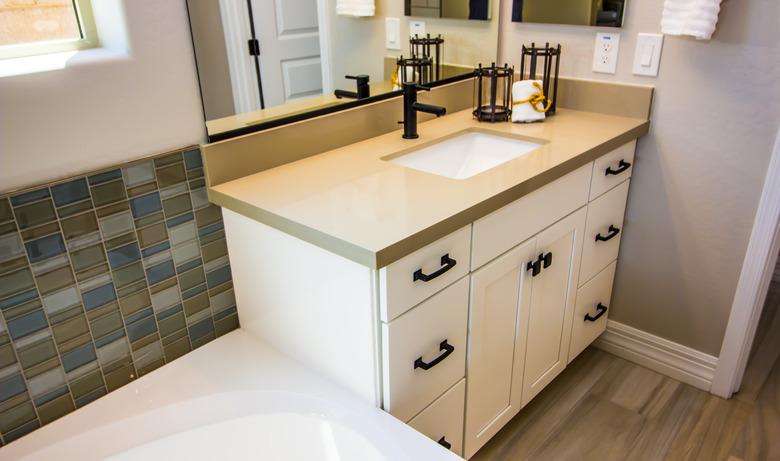How To Install A Glacier Bay Vanity Sink
You can dress up your bathroom by installing a Glacier Bay vanity sink. Unlike a wall-mounted or pedestal sink, a vanity sink is surrounded by a cabinet that provides storage for your bathroom items. As one of the Home Depot's brands, Glacier Bay products offer consumers the opportunity of saving money by being able to install the sink themselves. You'll have different options for styles of Glacier Bay vanity sinks, so be sure to consult the installation guide for your model to cover all the installation specifics.
Glacier Bay Vanity Sink Preinstallation
Depending on the Glacier Bay sink model you're installing, you'll need to follow some preinstallation steps and observe safety precautions. The sink cabinets are not designed to stand on or hang from, which children may be tempted to do.
After you remove the vanity sink from its box, check to make sure that all the parts are included by comparing each component against the hardware list provided in the packaging. The supply lines, faucet and sink drain aren't included with the vanity sink, so you'll want to have these on hand to complete the installation.
Since you'll be screwing the vanity sink cabinet to the wall, you'll likely be using a power drill. Wear safety goggles during installation to protect your eyes from flying debris. As an extra safety precaution, you may also want to wear work gloves to protect your hands from splinters, scrapes or power tool mishaps.
Leveling and Installing Glides
Some Glacier Bay vanity sinks have adjustable-height levelers on the legs. Before mounting the cabinet to the wall, turn the leveling screws (found underneath each cabinet leg) clockwise to lower the cabinet or counterclockwise to raise the cabinet. For other models, you'll have to insert shims underneath the legs to level the cabinet. Lay a level across the top of the vanity cabinet to determine if a leveling adjustment is needed.
You may have to install drawer glides on your Glacier Bay vanity sink. Before installing the glides, lay the cabinet down so the front is facing upward. For cabinets that are 30 inches wide or smaller, you'll use a soft hammer, such as a mallet, to attach four glides with nails, and for cabinets that are wider than 30 inches, you'll install eight glides. Insert the drawer over the glides according to the directions in your installation guide and make sure it's correctly seated.
Attaching Cabinet and Vanity Top
The cabinet of the vanity sink must be fastened to the wall by screwing the sink to at least one wall stud. To attach the cabinet to a stud, use No. 12 x 3-inch screws. To attach the cabinet to the drywall, drill holes and insert toggle bolts. To attach the cabinet to a concrete wall, insert No. 12 wall anchors into 1/4-inch predrilled holes and insert No. 12 x 3-inch screws into the wall anchors.
Apply a thin line of silicone caulking compound around the top edge of the cabinet. Set the vanity top on the cabinet, aligning it with the drain and P trap, and lightly press it into place on top of the silicone caulk. Apply another line of silicone caulk onto the seam between the wall and the back edge of the vanity top and wipe away any excess caulk with a soft, damp cloth. Finish up by installing the faucet, drain, P trap and water lines according to the manufacturer guidelines.
